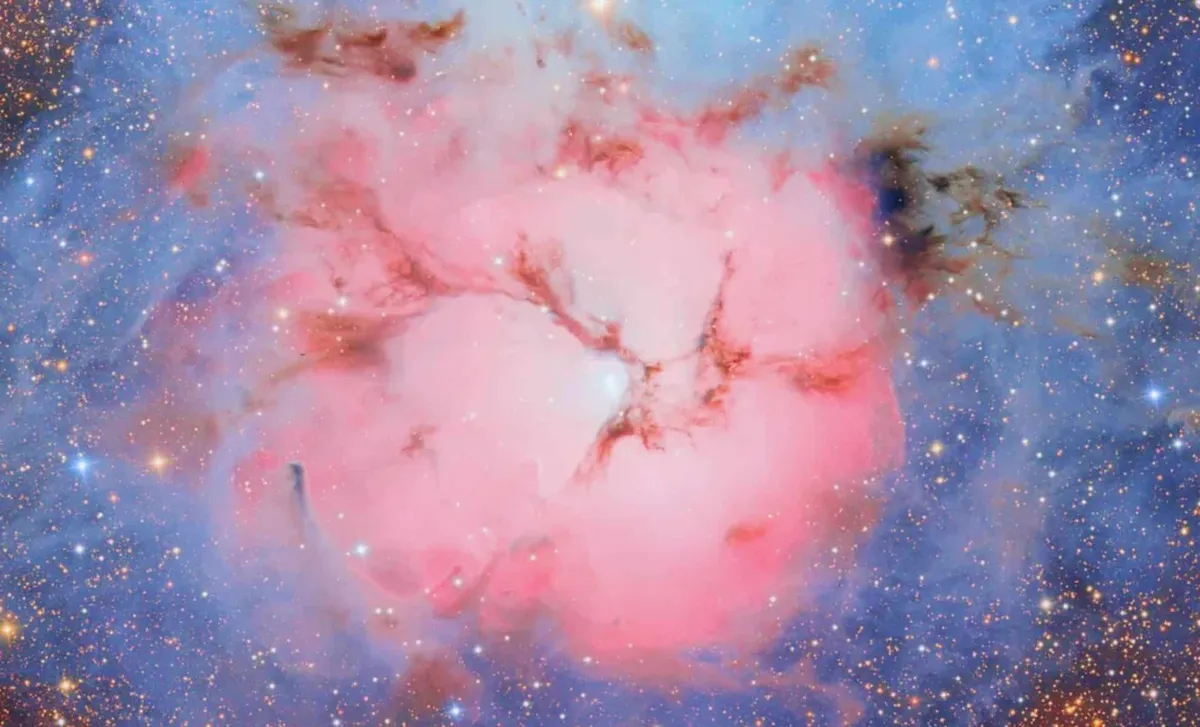
The Vera C. Rubin Observatory has made headlines with the release of its first close-up image of the cosmos, showcasing the breathtaking Trifid Nebula (Messier 20). Located 5,000 light-years away in the constellation Sagittarius, this extraordinary image was unveiled in June 2025 and is a product of the observatory’s innovative Legacy Survey of Space and Time (LSST) Camera. This advanced camera is capable of capturing the most detailed images of space ever recorded.
The image itself is a composite of 664 individual exposures taken over four nights in May 2025. It highlights the nebula’s intricate structures and vibrant colors—ranging from a deep pink to a soft blue—each hue revealing different aspects of the nebula’s composition. The remarkable clarity of this image is anticipated to serve as a cornerstone for future astronomical studies, as the Rubin Observatory embarks on a decade-long mission to map the Southern Hemisphere’s night sky.
The Trifid Nebula is celebrated for its unique appearance, characterized by its three distinct lobes that give it the name “Trifid,” meaning “three-lobed” in Latin. This nebula is a dynamic cosmic cloud of gas and dust, playing a crucial role in the process of star formation, which makes it a focal point of interest for astronomers.
The pink regions in the image represent an emission nebula, where ionized gas emits light due to the energetic radiation from newly formed stars. In contrast, the blue regions are classified as reflection nebulae, where light from nearby stars is scattered by dust particles, creating a luminous effect reminiscent of streetlights on foggy nights. Darker regions within the nebula, known as dark nebulae, act as barriers to light, adding depth to its complex structure. These dark lanes divide the nebula into its three distinct parts, which are vividly visible in the high-resolution image captured by the Vera C. Rubin Observatory.
Within these sections, active star formation occurs, driven by the intense radiation and gravitational forces at play. Newly born stars not only illuminate the nebula but also shape its surrounding gas and dust, producing the visually stunning patterns that are evident in the image.
Based in Chile, the Vera C. Rubin Observatory is equipped with the world’s largest digital camera, designed to capture high-resolution images of the sky with remarkable speed. The LSST Camera, boasting a resolution of 3,200 megapixels, enables the observatory to image vast portions of the sky every three to four days. This innovative capability will allow scientists to create an incredibly detailed and time-sensitive survey of the universe.
Over the next decade, the observatory is set to collect more data in a single year than has been amassed by all previous optical astronomy combined. Its mission extends beyond deep space objects like the Trifid Nebula; it also aims to identify previously unknown asteroids, supernovas, and potentially hazardous near-Earth objects. In its first week of operation alone, the observatory discovered over 2,100 new asteroids, underscoring the immense potential of this new astronomical tool.
Each patch of sky imaged by the observatory will be revisited up to 800 times, ensuring that no cosmic event goes unnoticed and providing a real-time survey of astronomical phenomena across the Southern Hemisphere.
The unveiling of the Trifid Nebula marks just the beginning of an exciting era for space exploration. The Vera C. Rubin Observatory is set to pave the way for groundbreaking discoveries that will reshape our understanding of the universe. Over the course of its ten-year survey, the observatory will seek answers to some of the most pressing questions in modern astronomy, including the nature of dark matter, the origins of cosmic phenomena, and the identification of new celestial bodies.
With its cutting-edge imaging technology, the observatory will also play a critical role in tracking the trajectories of near-Earth objects (NEOs). This will allow scientists to better predict potential risks posed by asteroids and comets, enhancing our ability to safeguard our planet.
The LSST Camera aboard the Simonyi Survey Telescope is the heartbeat of the Rubin Observatory’s capabilities. This digital marvel is designed to capture incredibly detailed images of the night sky, enabling researchers to detect objects that were previously invisible to traditional telescopes. The vast field of view of the LSST Camera allows it to image extensive sections of the sky quickly, solidifying its status as one of the most powerful astronomical tools available today.
The stunning image of the Trifid Nebula is just one example of the exceptional imagery produced by the Rubin Observatory. These images will facilitate astronomers in studying celestial objects over time, tracking their evolution and behaviors in unprecedented ways. With this technological advancement, the Rubin Observatory is poised to significantly expand our knowledge of the universe. By creating a comprehensive, time-lapse survey of the sky, the observatory will provide an abundance of data on various cosmic phenomena, from the birth of stars to the movement of distant galaxies.
As the observatory continues its work over the next decade, it will undoubtedly make significant contributions to our understanding of space and the overall safety of our planet.